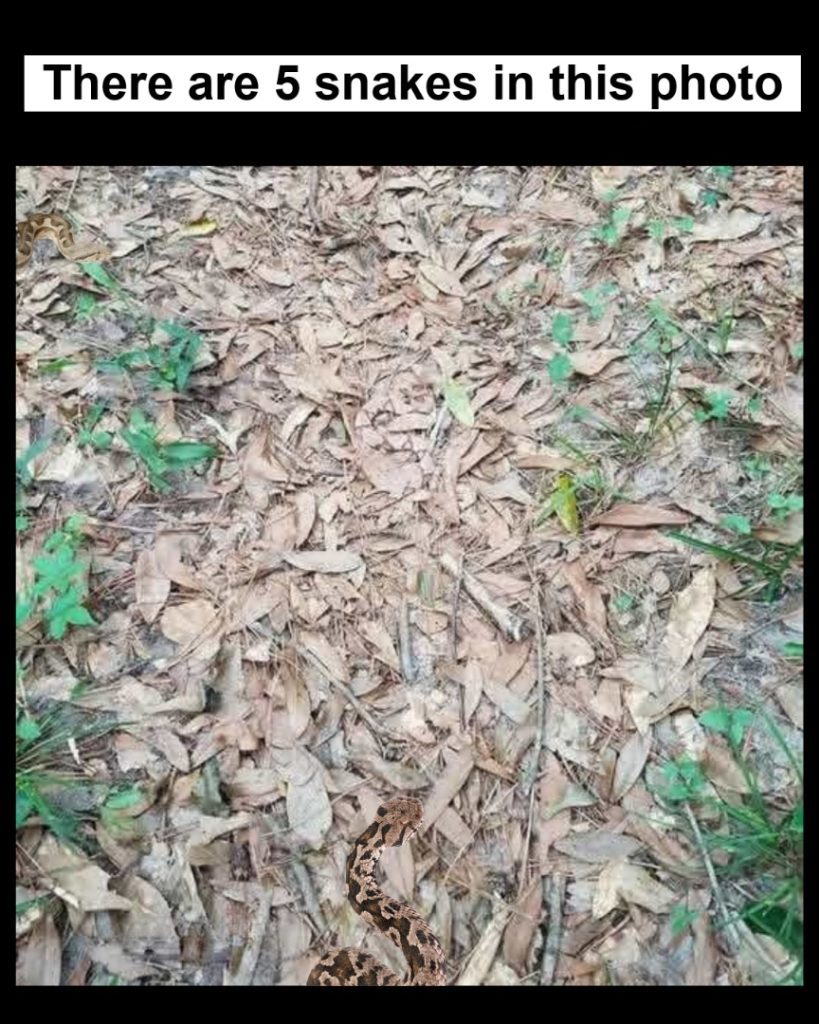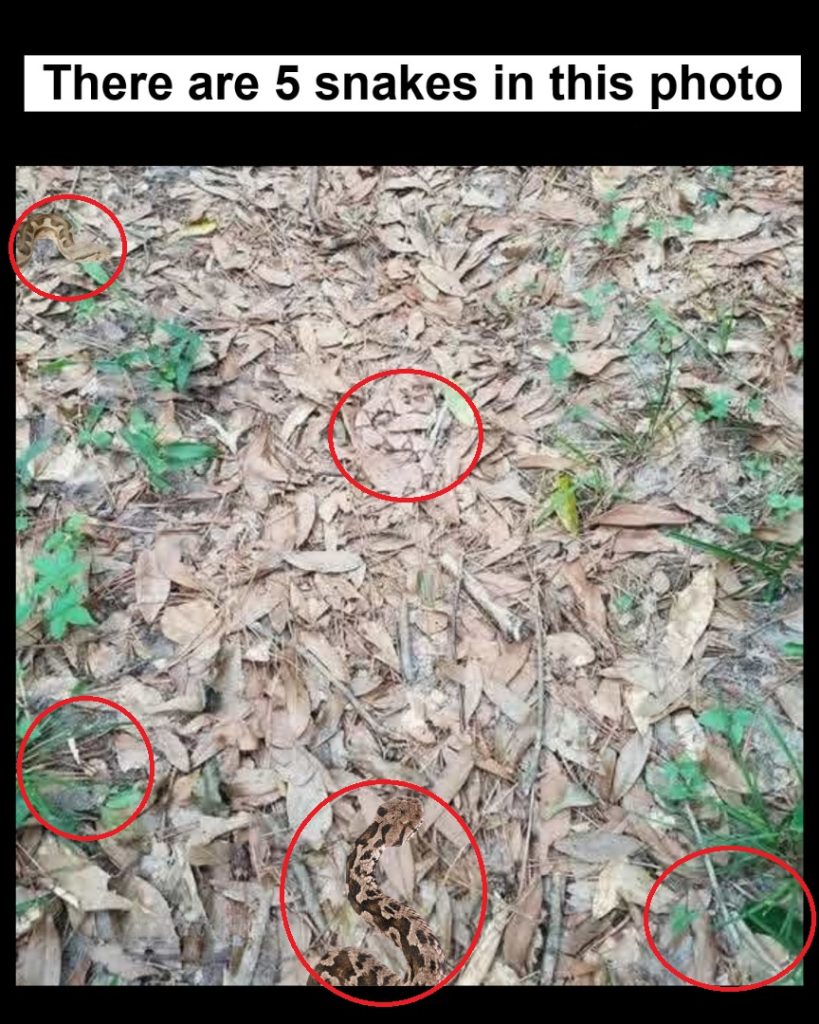Try before you scroll. Stare at the leaf-littered ground and trust your eyes. Somewhere in that crunchy carpet of brown and green are five snakes hiding in plain sight. Can you find them all without hints? Most people spot one, maybe two, and then hit a wall. Don’t panic—that’s exactly how camouflage is supposed to work. Ready to test your perception and your patience? Let’s play.

Why this visual riddle is so addictive
Our eyes evolved to notice motion and bold contrast, not motionless shapes designed to mimic their surroundings. Snakes in forest leaf litter break up their outline with banding and blotches, then freeze—turning themselves into “just another leaf.” Your brain keeps shouting, “Nothing to see here,” even while the answer is right in front of you. That clash between what’s there and what you think is there is the hook that keeps you looking.
To make it even more fun, this puzzle sets your attention on overdrive. Every curled stick looks s-shaped, every shadow looks like scales. Your job is to separate coincidence from the real thing. Think of it like detective work: lots of false leads, one correct culprit.
Video : Can You Spot the Hidden Snake? 🐍🔍
Common mistakes that cost you snakes
- Scanning too fast. Quick glances miss subtle borders: a curved edge, a triangular head, or a repeating blotch that doesn’t match surrounding leaves. Slow down.
- Trusting color over pattern. You expect “snake brown,” but good camouflage matches texture and pattern more than hue. Look for rhythm: alternating dark/light patches, hourglass shapes, or chains of ovals.
- Ignoring shadows and depth. A slight bulge in the leaf layer can betray a body underneath. Real animals make real contours; printed leaves don’t.
- Tunnel vision. Once you see one snake, your brain fixates on that area and forgets the rest. Force yourself to scan the whole frame in a grid.
- Chasing sticks and roots. Sticks have clean, continuous edges. Snake bodies curve with variable width and often show a faint scale sheen or soft outline where body lifts off the ground.

A step-by-step method to solve “camouflage” puzzles
Step 1: Divide and conquer. Mentally split the image into a 3×3 grid. Spend 10–15 seconds on each cell before moving on. This prevents you from camping on one spot forever.
Step 2: Hunt for the “S.” Nature rarely lays sticks in smooth S-curves. If you see an elegant curve, that’s a candidate.
Step 3: Pattern > color. Scan for repeating blotches or bands that continue across curves—leaves rarely keep a perfect rhythm; animal patterns do.
Step 4: Edge check. Follow any suspicious outline for 3–5 cm (about an inch or two on screen). Real bodies keep a consistent thickness; leaf gaps don’t.
Step 5: Head search. Look for small triangular or spade-shaped heads and a short neck transition. Even when the body disappears, the head often gives the game away.
Step 6: Verify with context. Is the suspected object casting a soft shadow? Is there slight lift from the substrate? Those micro-clues scream “living thing.”
Keep that playbook handy, then compare your suspects with the placements below.
Video : Only 1% Can Spot the Hidden Snake 🐍 | Test Your Eyesight!
Answer key: the five snakes (circled in the solution image)
- Snake #1 – Top-left corner: Look just inside the upper left. You’ll see a short, banded section with a rounded head emerging from the leaves. The alternating light/dark patches don’t match nearby leaf veins—that’s your first snake.
- Snake #2 – Upper-middle, slightly right of center: In the mid-top area, a coiled body masquerades as overlapping leaves. The tell is the repeating chain of blotches forming a near-perfect ring; leaves don’t make closed loops like that.
- Snake #3 – Bottom-center (largest, most obvious body): This is the “anchor” snake many spot first. An S-shaped body with bold, dark saddles crosses the lower middle. Notice the consistent thickness and soft shadow where the body arches over small twigs.
- Snake #4 – Bottom-left quadrant: Near the clustered green sprigs, a thinner body threads through grass stems. The subtle banding and gentle curve separate it from straight grass blades.
- Snake #5 – Bottom-right quadrant: Look among the angled sticks and leaf tips. A partial body segment with mottled pattern peeks out, its contour slightly lifted from the litter—another giveaway that it’s not a flat leaf.

If you marked those five circled locations, congrats—you beat a puzzle that trips up most viewers in under a minute.
How the image fools your eyes (and how to fight back)
Figure–ground confusion. Your visual cortex constantly decides what’s “object” and what’s “background.” Camouflage breaks the outline so the snake is grouped with the background. Solution: search for continuity—edges that stay smooth as they travel, even when the pattern changes.
Texture matching. The leaf litter has blotches, so the snake also wears blotches. Your brain assumes “same texture = same thing.” Solution: watch for rhythm—regular intervals that leaves rarely keep.
Expectancy bias. If you “know” the snake should be bright or coiled, you’ll ignore a straight or dim segment. Solution: deliberately vary your hypothesis: “What if this one is stretched? What if only the head shows?”
Scale blindness. On screens, a 4-inch stick and a 2-foot body can look similar. Solution: use reference points (leaf size, twig width) to judge realistic thickness for a snake.
Conclusion: Keep Training Your Eyes and Your Mind
Spotting all five snakes in this puzzle wasn’t just about sharp eyesight—it was about patience, logic, and learning how to notice the smallest of details. At first glance, the photo looks like nothing more than a pile of dry leaves, but with focus and the right method, the hidden truth reveals itself. That’s the magic of puzzles like these: they train you to question what you see and push past first impressions.

If you managed to find all five snakes on your own, give yourself a pat on the back—you’ve got sharper vision than most! If you struggled, don’t worry. The real value comes from practicing, learning where you went wrong, and improving the next time you take on a similar challenge.
Now it’s your turn to join the conversation:
- Which snake was the hardest for you to spot?
- Did you notice any clever tricks that helped you solve it?
- How long did it take you to find all five?
Drop your answers in the comments below, and don’t forget to share this puzzle with friends or family. It’s a great way to test who has the sharpest eyes and the most logical approach.
Remember, every challenge like this is more than just a game—it’s a workout for your brain. The more you play, the more you sharpen your focus, memory, and problem-solving skills. So keep trying new puzzles, optical illusions, and logic games. Each one is a small step toward developing eagle eyes and a sharper mind.
So—are you ready for the next challenge? 👀